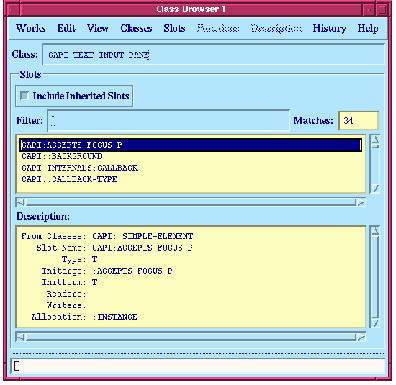*.







2 A Short Tutorial
* once again.
* variable still contains the value of the text input pane object. This means that it is easy to perform several actions on that object. Notice further that the environment is aware that the object has been changed: the value returned by* reflects the change to the text slot that you made in the last section.
*.

The class browser contains more areas than the inspector. Below the menu bar, the name of the current Common Lisp class is printed. The list below the Filter area displays the slots available to the current class, and a Description area displays the description of any selected slot. The Filter area works in the same way as the inspector's Filter area. There is also a button labeled Include Inherited Slots. Clicking on this button lets you switch between displaying all the slots defined on the current class and all its superclasses, and only those slots defined directly on the current class. By default, slots defined on any superclasses (inherited slots) are shown in the main area.
text and then press Return.
CAPI-INTERNALS:TEXT slot in the main area of the class browser. A description of the slot appears in the Description area, including information such as the initargs, readers, and writers of the slot.
capi:text-input-pane-text, and a writer,(setf capi:text-input-pane-text). We can use this information to programmatically change the text shown in the text input pane.
(setf (capi:text-input-pane-text *) "Hello world!")The text displayed in the text input pane is updated to reflect the new value you have specified. Notice how you were able to use the
* variable to refer directly to the text input pane object itself.






Generated with Harlequin WebMaker